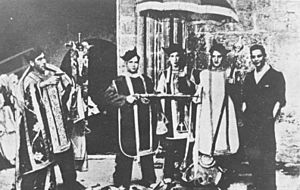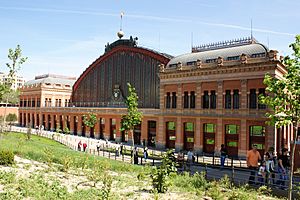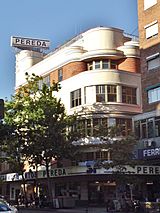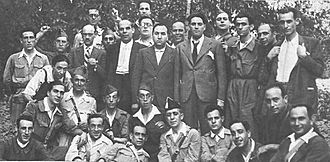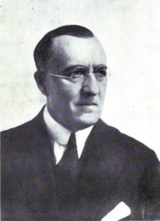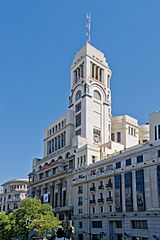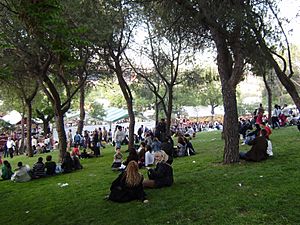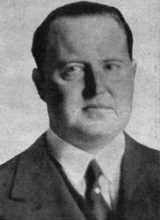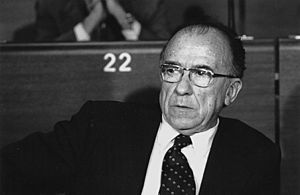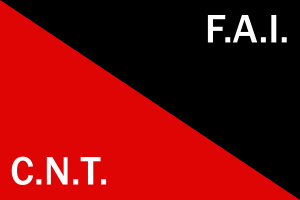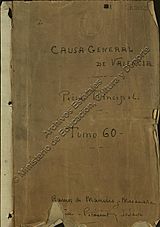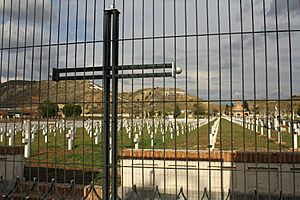Republican repression in Madrid (1936–1939) facts for kids
The Republican actions in Madrid (1936–1939) were steps taken against people thought to be against the Second Spanish Republic. These actions were carried out by government groups, party armies (militias), and other mixed organizations. Some actions followed legal rules and involved courts. But others were outside the law or clearly against it.
Legal actions included executions, taking property, fines, firing people from jobs, jail, forced moves, forced labor, or losing civil rights. Actions outside the law included executions, rough treatment, holding people in secret, and destroying or taking property. Most of these actions happened in 1936, but they continued in the years after. We don't know the exact total number of people affected. Records show that one group held at least 18,000 people in 1936. The number of people executed is debated. Some lists have about 9,000 names, while others have around 11,500. Historians still disagree on many details about these events in Madrid during the Spanish Civil War.
Contents
How Things Were Organized
When the Spanish Civil War began, Madrid had three main police forces. They all reported to the Minister of Interior. These were the Guardia Civil, Guardia de Asalto, and the regular police.
The Guardia Civil was changed a lot and then dissolved in August 1936. A new service, Guardia Nacional Republicana (GNR), took its place. But the GNR did not play a big role in these actions. The Guardia de Asalto continued, but its Madrid units were sent to the war front.
The regular police, especially its detective part called Cuerpo de Investigación y Vigilancia (CIV), changed a lot. Many old staff were removed, and new members joined. These new members often came from revolutionary parties. Some CIV units, like Brigada Atadell, became important in carrying out the Republican government's orders.
When the war started, weapons were given to civilians, mostly members of political parties and worker unions. This led to many armed groups called militias. For the first few months of the war, these militias were more powerful than the official police in Madrid. They often set up their own detention and questioning places, known as checas. There were about 350 of these places, but most disappeared by early 1937.
Militias and official police usually worked together. For example, militias used police records to find suspects. They sometimes handed over prisoners to the official security office, or more often, took prisoners from official jails.
In August 1936, the main security office (DSG) and major parties created a new group called Comité Provincial de Investigación Pública (CPIP). This was a paid police service. Its job was to stop anti-Republican plots and arrest people involved. In theory, prisoners were to be sent to the DSG. But in practice, the CPIP could order executions. The CPIP was a key law enforcement group for about 100 days before it was dissolved in November 1936.
Other new groups were also formed. Inspección General de Milicias (IGM) was an army group meant to help militias. Milicias de Vigilancia de la Retaguardia (MVR) was a mix of state police and party militias. It became very active before being dissolved in December 1936.
In December 1936, all police groups were combined into a new service called Cuerpo de Seguridad (CS). This new force became the main police structure. However, in June 1937, a new unit called Departamento Especial de Información de Estado (DEDIDE) was created. This was a counter-intelligence agency.
Two months later, in August 1937, the army created Servicio de Investigación Militar (SIM). From then on, SIM became the main government tool for fighting suspected plots. In March 1938, it took over DEDIDE.
How They Operated
The Republican security groups used different ways to find suspects.
- Tips and denunciations: People would give information, either from those working with security (like porters from the UGT union) or regular citizens.
- Systematic searches: They used old police files or papers found in raids on right-wing party offices.
- Street patrols: They watched key places or the black market.
- Traps: Some units specialized in setting traps, like the fake embassy of Siam or the so-called Túnel de Usera.
Some people were caught and executed right away. Many others were put in jail. This could be in official prisons, police stations, or special detention centers run by different groups. These centers were often in old convents or large buildings. Most people were held for a few months, but some were held much longer.
After arrest, people were questioned. Depending on the questioning, they might be freed, moved to another detention unit, kept in custody, sent to a trial, or chosen for execution. There are no exact numbers. But members of one group (CPIP) said that about 50% of prisoners were freed, 25% were kept in jail, and 25% were executed.
Suspects who went to trial faced different types of courts. The regular courts were too busy. So, in August 1936, a special court was set up for "rebellion and sedition" crimes. Other special courts were also created later. Most of these courts had a mix of professional judges and regular citizens as jury members. They allowed some defense, but there was no appeal. These courts were meant to be fast, but they often weren't. For example, only 389 people appeared before the Madrid Special Tribunal in 1936. Records show that about 50% of defendants were found innocent, and about 8% were sentenced to death. A well-known case was the execution of Joaquín Fanjul.
Executions could happen during or soon after arrest, in prison, or at special execution sites. These might follow a formal decision or happen without any official process. The number of immediate executions was highest in the first months of the war and then dropped quickly. By late 1937, more prisoners were sent to labor camps, often run by SIM. These camps were not like later Nazi death camps, but some prisoners died because of very bad conditions. One such camp in Madrid Province was in Ambite.
Who Were the Victims?
No source tells us exactly how many Madrid residents were affected by these actions. Most estimates focus only on those executed. They do not include people who were fined, jailed, forced to move, or lost their civil rights. One study suggests that the CPIP alone might have held 18,000 people.
Early estimates of executed people were very high, sometimes tens of thousands. For example, in early 1937, The Guardian newspaper suggested 40,000. A report from 1939 claimed 60,000, but later reduced this to 18,000. It was hard to check these numbers until after the Franco era ended.
Most experts now use a figure of about 8,815 as a general estimate. However, some authors believe the total number of deaths in the province was around 15,000, especially if only identified victims are counted. Even the lowest estimate of 8,815 makes Madrid one of the areas with the highest level of such actions in the Republican zone.
Many famous people were victims in Madrid. These included writers like Ramiro Maeztu Whitney and Pedro Muñoz Seca. Many politicians were also executed, such as Melquíades Álvarez and Ramiro Ledesma Ramos. High-ranking military officers like Joaquín Fanjul Goñi and Julio Ruiz de Alda also lost their lives. Important religious figures like Pedro Poveda Castroverde were killed. Even sports figures like Ramon Triana Arroyo were affected, and Ricardo Zamora Martínez almost died.
When and Where It Happened
There are no exact year-by-year numbers for the scale of these actions in Madrid. However, most studies agree that most of the violence happened in 1936. One historian says that 96% of executions took place in 1936. Other studies support this idea.
Detailed analysis of small-scale executions shows they were highest in July (400), August (650), and September (550). Numbers were lower in October and November (around 300 each) and even lower in December (below 100). But this doesn't mean the total number of victims decreased throughout 1936.
The detention centers in Republican Madrid were spread out across the city. On average, there were 4 "checas" per square kilometer. Even the suburban area of Puente de Vallecas had 17 such places. The main office of CPIP was in central Madrid. The DGS offices were in the Salamanca district. Until mid-1937, most arrests happened in the Chamberi and Buenavista districts.
The places where executions happened changed over time. In the first months, prisoners were usually taken to western parts of Madrid or its western suburbs. These included Aravaca in the North, Casa de Campo in the center, and Pradera de San Isidro in the South. These areas were less populated and seemed more suitable for executions.
However, as Nationalist troops got closer from the West, areas like Aravaca became battlefields. So, executions moved to the East and South, especially in Rivas-Vaciamadrid and near Cimiterio del Este. Paracuellos de Jarama was chosen for the largest executions because it was far from the front lines, easy to reach from Madrid, and local councils were seen as reliable.
Key People Involved
In the first weeks of the war, Sebastián Pozas Perea was the Minister of Interior. He was not very involved in Madrid issues but was okay with the revolutionary groups. His second-in-command, José Alonso Mallol, tried to keep state structures working but resigned in July 1936.
Manuel Muñoz Martínez replaced him. From early September, he reported to the new minister, Angel Galarza Gago. These two were key officials until November 1936, when they left Madrid. After that, their influence over state security in Madrid lessened.
The Junta de Defensa de Madrid (JDM) was set up in November 1936. Its public order section was led by Santiago Carillo Solares and his deputy José Cazorla Mauré. When Carrillo left, Cazorla became the most powerful person in Madrid's security forces until April 1937.
Later, in the summer of 1937, Gustavo Durán Martínez became head of the Madrid SIM. He was replaced by Ángel Pedrero García in October 1937. Pedrero was very important in Madrid's policing for 17 months. During the Casado coup in March 1939, he helped the rebels by arresting many Communist figures in Madrid.
Some individuals briefly led important security groups. Segundo Serrano Poncela headed the DSG Security Council for a few weeks. He gave orders to remove prisoners who ended up at Paracuellos. Federico Manzano Govantes led MVR and helped with the Paracuellos extractions. Ramón Rascón Ramírez was involved in several security roles and helped select prisoners for Paracuellos. Manuel Salgado Moreira led military counter-intelligence and organized some clever scams.
Other people became known for being very effective in carrying out the new order, even if they didn't hold top positions. Agapito García Atadell became famous as the head of a CIV squad. Valero Serrano Tagueña and Marcos García Redondo led other brigades. Felipe Sandoval Cabrerizo was a member of a revolutionary court and a squad leader. He was important in actions at Modelo prison and Paracuellos. Fernando Valenti Fernandez worked on counter-espionage and set traps. Eduardo Val Bescós was the chief of the CNT Defence Committee, responsible for Anarchist militias.
Political Influences
At first, key people in Madrid's public order roles were usually moderate Republicans or Socialists. For example, Minister Galarza was a Socialist. Some experts say that in the early weeks, there was an attempt to keep "normal policing." But this changed when the CPIP was created. This new group showed the growing power of party and union militias.
It's hard to know exactly how much influence each political group had. But studies of the "checas" (detention centers) suggest that the anarchist CNT-FAI and the communist PCE each controlled about 25% of them. The rest were shared by the PSOE (Socialist Party), JSU, and other Republican groups. For larger detention centers, CNT-FAI had more control (34%), followed by PCE (19%) and PSOE (13%).
The CPIP itself was supposed to be controlled by a board with members from many parties. But its investigative teams were mostly anarchist (40% from CNT-FAI). The state police (CIV) also changed. Many new recruits were Socialists (31% from UGT, 17% from PSOE). The MVR, a mix of state police and militias, was also largely controlled by Socialists (59% from UGT).
Political control of state security in Madrid changed when the government left the capital. The Communists took control of the public order department within the JDM. This was seen in the appointments of Carillo and Cazorla. The Socialist-dominated CPIP and IGM were soon dissolved.
However, late 1936 and early 1937 saw growing conflict between anarchists and communists. This led to the dissolution of JDM. But Communists still kept control over some CIV brigades. Of the new groups formed in mid-1937, the Madrid DEDIDE was controlled by the PCE. The Madrid SIM was mostly in the hands of the Socialists. The new police force, Cuerpo de Seguridad, was mostly made of former CPIP and MVR members, suggesting the Socialists gained more power.
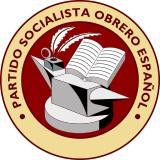
For most of 1938, Madrid's public order system seemed balanced between Communists (DEDIDE), Anarchists (military counter-intelligence, militias), and Socialists (Seguridad, SIM). This balance broke during the Casado coup in March 1939. The Socialist-led SIM and Anarchist-led military units crushed the Communist resistance. Some Communist figures were executed, like Barceló. Others were imprisoned, like Cazorla.
What Happened After
Few leaders of Madrid's policing units were caught by the Nationalists during the war. But Atadell was caught in November 1936. Some high officials, like Galarza and Carrillo, crossed into France in early 1939. Most of those still involved left Madrid in the final weeks of the war. But few managed to leave Spain. Many, like Girauta and Pedrero, were caught in Alicante in April 1939.
Some managed to hide and tried to start new lives with false identities. But the Francoist authorities were determined to find them. Mancebo and Cazorla were caught in August 1939. Many were questioned harshly. Most were executed, some by garrote. Others died in exile. In total, out of 1,143 people identified as active in Madrid's Republican security system, about 90 are known to have been executed after the war. Some were jailed but later freed.
After the war, the Spanish government started a huge investigation into Republican actions across the country. This was called the Causa General. It collected a lot of documents to help with investigations, historical research, and propaganda. The authorities launched a big campaign to show Republican rule in Madrid as a time of great cruelty. They honored the victims. Many books and some films were made about what was called the "Red Terror." Madrid was often featured. Some execution sites, like Paracuellos de Jarama, became memorial sites.
After Franco died, public attention shifted to the Nationalist actions. The memory of victims of Republican violence in Madrid was kept alive mostly by their families. But it gained new attention sometimes, especially with Santiago Carrillo's return to politics. This caused a big debate that lasted for decades. New books, like Ian Gibson's 1983 work on Paracuellos, also brought public attention back.
In 2015, a committee marked some places in Madrid, like the Bellas Artes checa and Modelo prison, as "sites of historical memory." This caused ongoing public debate about the list of sites and the exact words used. It was planned to put up plaques remembering the victims. But legal advice said this might go against the Ley de Memoria Histórica, which bans praising the military uprising, the Civil War, and the dictatorship's repression. So far, small plaques are only in private places like religious buildings. Debates about other city hall plans continue.
How Historians Study This
Historians have written a lot about the violence during the Civil War, and new studies keep coming out. Before 1975, most studies focused on the violence behind Republican lines. Later, attention shifted to Nationalist actions. Recently, there's been new research on the Republican zone, including several major works about Madrid. Some specific events, like the Paracuellos killings, also have many books written about them.
However, these studies do not fully answer all questions. Many issues are still debated by historians. In the early 21st century, some hoped that the discussion was becoming more "normal." But this was wrong. Instead, the debate has become "more heated than ever before."
See also
 In Spanish: Represión republicana en Madrid durante la guerra civil española para niños
In Spanish: Represión republicana en Madrid durante la guerra civil española para niños
- Red Terror (Spain)
- Paracuellos massacres
- Madrid Defense Council
- Revisionism (Spain)


